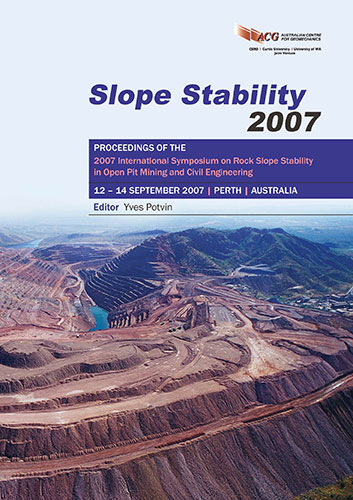Use of an Excavation Compliance Indicator to Assess Conformance to Slope Design

|
Authors: Seery, J; Lapwood, J |
DOI https://doi.org/10.36487/ACG_repo/708_28
Cite As:
Seery, J & Lapwood, J 2007, 'Use of an Excavation Compliance Indicator to Assess Conformance to Slope Design', in Y Potvin (ed.), Slope Stability 2007: Proceedings of the 2007 International Symposium on Rock Slope Stability in Open Pit Mining and Civil Engineering, Australian Centre for Geomechanics, Perth, pp. 431-437, https://doi.org/10.36487/ACG_repo/708_28
Abstract:
The compilation of factors associated with the construction of a slope has been collectively termed the excavation compliance indicator. The excavation compliance indicator is a tool that can be used to quantify the adherence to slope design in the operational mine environment. It is the collection of measurements pertaining directly to batter face angle and berm width and indirectly to the inter-ramp angle. The characteristics are measured from mine survey as-built pickups and Sirovision triangulations which have been imported into Maptek Vulcan. The characteristics are compared directly to the design batter face angle, berm width and inter-ramp angle. To date, the excavation compliance indicator process has been undertaken on a number of pits in the West Pilbara Mine Operations at Pilbara Iron. The aim of undertaking this analysis is to assess the quality of excavation of slope angles and construction of berms to check conformance to design slope parameters. In the analysis of mine survey as-built pickup data for the Tom Price South East Prongs pit, the as-built batter face angle was found to be on average 4 degrees lower than design batter face angle. It was found that in general, the average as-built batter face angle for the mine survey pickup was no more than 2 degrees lower than the interpreted Sirovision model batter face angle. This work will help to drive the reconciliation process between the geotechnical design parameters and actual excavation performance. There is a direct correlation of the excavation compliance indicator to the drill and blast design and the final wall excavation process.
References:
Alejano, L.R., Pons, B., Bastante, F.G., Alonso, E. and Stockhausen, H.W. (2007) Slope geometry design as a means
for controlling rockfalls in quarries. International Journal of Rock Mechanics and Mining Sciences 44. Elsevier,
pp. 903-921.
Bye, A.R. and Bell, F.G. (2001) Geotechnical applications in open pit mining. Geotechnical and Geological
Engineering 19. Kluwer Academic Publishers. Netherlands, pp. 97-117.
Department of Consumer and Employment Protection (1999) Geotechnical considerations in open pit mines, guideline.
geoconsguideopenpit.pdf, pp. 15-16.
Hoek, E. and Bray, J.W. (1994) Rock slope engineering. Revised third edition. Institution of Mining and Metallurgy,
Melbourne.
McMahon, B. (1971) A statistical method for the design of rock slopes. Proceedings first Australia – New Zealand
conference geomechanics, Melbourne, pp. 314-321.
McMahon, B. (1974) Design of rock slopes against sliding on pre-existing fractures. Proceedings 3rd Congress,
Volume II Part B, International Society of Rock Mechanics, Denver, pp. 803-808.
Miller, S.M., Girard, J.M. and McHugh, E. (2000) Computer modelling of catch benches to mitigate rockfall hazards in
open pit mines. Pacific Rocks 2000 (Proceedings 4th North American rock mechanics symposium), Girard, J.,
Liebman, M., Breeds, C. and Doe, T. (eds.), Balkema. Rotterdam, pp. 539-545.
Morriss, P. and Stoter, H.J. (1983) Open-cut slope design using probabilistic methods. 5th ISRM congress on rock
mechanics, Section C. International Society of Rock Mechanics. Melbourne, pp. 107-113.
Morriss, P. (1984) Understanding and applying probabilistic concepts to rock slope design. 4th Australia – New
Zealand conference on geomechanics, Perth, Western Australia. Institute of Engineers.
Singh, V.K., Singh, J.K. and Kumar, A. (2004) Geotechnical study and optimal design at Lakjura opencast coal mine,
India. International Journal of Rock Mechanics and Mining Sciences. Elsevier.
Singh, V.K. and Singh, T.N. (1999) Geotechnical study of the optimum design of the Chandmari coppermine,
Rajasthan, India. Engineering Geology 53 pp, 47-55. Elsevier Science.
Tsidzi, K.E.N. (1997) An engineering geological approach to road cutting slope design in Ghana. Geotechnical and
Geological Engineering. Chapman and Hall.
Whyatt, J.K., MacLaughlin, M. and Miller, S. (2004) Analysis of bench crest performance at the Yellowstone Mine: A
case study. Proceedings 39th symposium on engineering geology and geotechnical engineering: research to
practice, McLaughlin, M. and McNearny, R. (eds.) Montana Tech of the University of Montana, pp. 149-163.
Rock Slope Stability
Slope Stability 2007, Perth, Australia 437
© Copyright 2025, Australian Centre for Geomechanics (ACG), The University of Western Australia. All rights reserved.
View copyright/legal information
Please direct any queries or error reports to repository-acg@uwa.edu.au
View copyright/legal information
Please direct any queries or error reports to repository-acg@uwa.edu.au